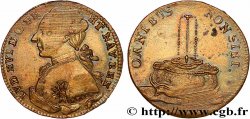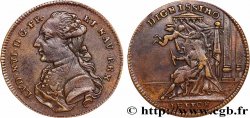正面
正面的文字 LUD. XVI. D. G. FR ET. NAV. REX.
正面的说明书 Portrait de Louis XVI à gauche, sans buste et cheveux attachés.
背面
背面的文字 DAS. GLICK (SIC). LACHET. DER. ANKER. WACHET..
背面的说明书 Une croix ancrée traversant un globe ailé.
历史细节
LOUIS XVI
(05/10/1774-01/21/1793)
After the days of October 5 and 6, 1789, the Parisians brought back from Versailles to Paris, "the baker, the baker and the little baker" (royal family) who settled in the Tuileries. On November 2, 1789, the property of the Church was nationalized. The kingdom is divided into 83 departments in December. On April 17, 1790, the assignat became paper money and became legal tender, then forced tender from September. The property of the clergy is put up for sale as "national property". On June 19, titles and nobility are abolished. On July 12, the Civil Constitution of the Clergy is voted. The Federation Day, July 14, seems to mark the end of the Revolution and symbolizes what unites the King, the kingdom and the people. Mirabeau died on April 12, 1791. The passage of the Le Chapelier law prohibited corporations, associations and professional unions and suppressed the right to strike. The King was arrested in Varennes on June 22 while trying to escape. La Fayette had the crowd fired at the Champ de Mars on July 17, 1791. On September 3, the Legislative Assembly replaced the Constituent Assembly, which separated. The King takes an oath to the Nation.








 对产品描述纠错
对产品描述纠错 打印
打印 分享我的选择
分享我的选择 提问
提问 Consign / sell
Consign / sell
 产品介绍
产品介绍









